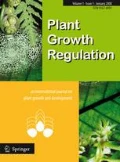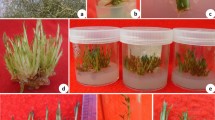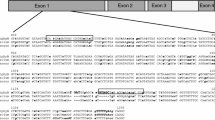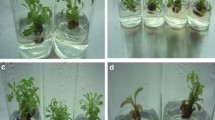Abstract
The possible involvement of ethylene in in vitrorooting of faba bean (Vicia faba L.) shootsregenerated on medium containing thidiazuron wasinvestigated. The effects of the ethylene precursor1-aminocyclopropane-1-carboxylic acid (ACC) and threeethylene inhibitors, silver nitrate (AgNO3),acetyl salicylic acid (ASA) and cobalt chloride(CoCl2) on root formation were tested in vitrousing TDZ-induced shoots of faba bean accession 760.ACC inhibited root formation. In contrast, ethyleneinhibitors promoted root formation, AgNO3 at theappropriate concentrations enhanced root emergence andincreased root number per shoot, root growth rate, androot length. Both CoCl2 and ASA at theappropriate concentrations increased rootingefficiency. These promotive effects may result from areduction in ethylene concentration or inhibition ofethylene action. The results offer a new approach toimprove the rooting efficiency of TDZ-induced shootsof faba bean and possibly of other plant species.
Similar content being viewed by others
References
Bandyopadhyay S, Cane K, Rasmussen G and Hamill JD (1999) Efficient plant regeneration from seedling explants of two commercially important temperate eucalypt species-Eucalyptus nitens and E. globilus. Plant Sci 140: 189–198
Biondi S, Diaz T, Iglesias I, Gamberini G and Bagni N (1990) Polyamines and ethylene in relation to adventitious root formation in Prunus avium shoot cultures. Physiol Plant 78: 474–483
Bollmark M and Eliasson L (1990) Ethylene accelerates the break down of cytokinins and thereby stimulates rooting in Norway Spruce hypocotyl cuttings. Physiol Plant 80: 534–540
Cameron AC, Fenton CAL, Yu Y, Adams DO and Yang SF (1979) Increased production of ethylene by plant tissue treated with 1-aminocyclopropane-1-carboxylic acid. Hort-Science 14: 178–180
Coleman W, Huxter T, Ried DM and Thorpe TA (1980) Ethylene as an endogenous inhibitor of root regeneration in tomato leaf discs cultured in vitro. Physiol Plant 48: 519–525
Gonzalez A, Rodriguez R and Tames RS (1991) Ethylene and in vitro rooting of hazelnut (Corylus avellana) cotyledones. Physiol Plant 81: 227–233
Hutchinson MJ, Murr DP and Krishnaraj (1997) Does ethylene play a role in thidiazuron-regulated somatic embryogenesis of geranium (Pelargonium × horturum) hypocotyl cultures. In Vitro Cell. Dev. Biol. 33: 136–140
Khalafalla MM and Hattori K (1999) A combination of thidiazuron and benzyladenine promotes multiple shoot production from cotyledonary node explants of faba bean (Vicia faba L.). Plant Growth Regulation 27: 145–148
Ma JH, Yao JL and Morris B (1998) Ethylene inhibitors enhance in vitro root formation from apple shoot cultures. Plant Cell Rep 17: 211–214
Mensuali-Sodi A, Panizza M and Togononi F (1995) Endogenous ethylene requirement for adventitious root induction and growth in tomato cotyledons and lavandin microcuttings in vitro. Plant Growth Regul 17: 205–212
Mohamed MF, Read PE and Coyne DP (1992) Dark preconditioning, CPPU and thidiazuron promote shoot organogenesis on seedling node explants of common and faba beans. J Amer Soc Hort Sc 117: 668–672
Murashige T and Skoog F (1962) A revised medium for rapid growth and bioassays with tobacco tissue cultures. Physiol Plant 15: 473–497
Murthy BNS, Murch SJ and Saxena PK (1998) Thidiazuron: A potent regulator of in vitro plant morphogensis. In Vitro Cell. Dev. Biol-Plant 34: 267–275
Nakajima N, Mori H, Yamazaki K and Imazeki H (1990) Molecular cloning and sequence of a complementary DNA encoding 1-aminocyclopropane-1-carboxylate synthase induced by tissue wounding. Plant Cell Physiol. 31: 1021–1029
Nordstrom AC and Eliasson L (1993) Interaction of ethylene with indole-3-acetic acid in regulation of rooting in pea cuttings. Plant growth Regulation 12: 83–90
Roustan JP, Latche and Fallot J (1989) Effet de 1, acide salicylique et de 1, acide acetylsalicylique sur la production d, ethylene et 1, embryogenese somatique de suspensions cellulaires de carotte (Dcucus carota L.). CR Acad Sci Paris 308: 395–399
Suttle JC (1985) Involvement of ethylene in the action of the cotton defoliant thidiazuron. Plant Physiol 78: 272–276
Suttle JC (1984) Effect of the defoliant thidiazuron on ethylene evolution from mung bean hypocotyl segments. Plant Physiol 75: 902–907
Tegeder M, Gebhardt D, Schieder O and Pickardt T (1995) Thidiazuron-induced plant regeneration from protoplast of Vicia faba cv. Mythos. Plant Cell Rep 15: 164–169
Yang SF (1985) Biosynthesis and action of ethylene. Hort-Science 20: 41–45
Yip WK and Yang SF (1986) Effect of thidiazuron, a cytokinin-active urea derivative, in cytokinin dependent ethylene production systems. Plant Physiol. 80: 515–519
Author information
Authors and Affiliations
Corresponding author
Rights and permissions
About this article
Cite this article
Khalafalla, M.M., Hattori, K. Ethylene inhibitors enhance in vitro root formation on faba bean shoots regenerated on medium containing thidiazuron. Plant Growth Regulation 32, 59–63 (2000). https://doi.org/10.1023/A:1006305123585
Issue Date:
DOI: https://doi.org/10.1023/A:1006305123585




